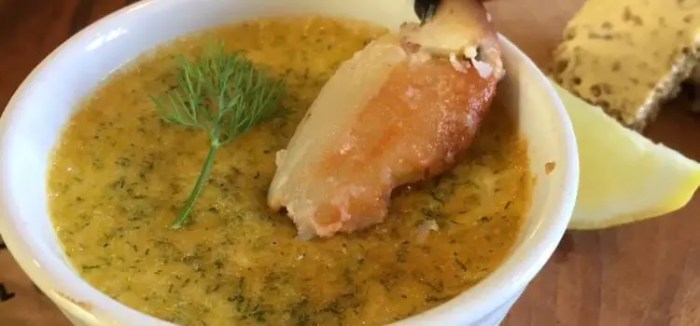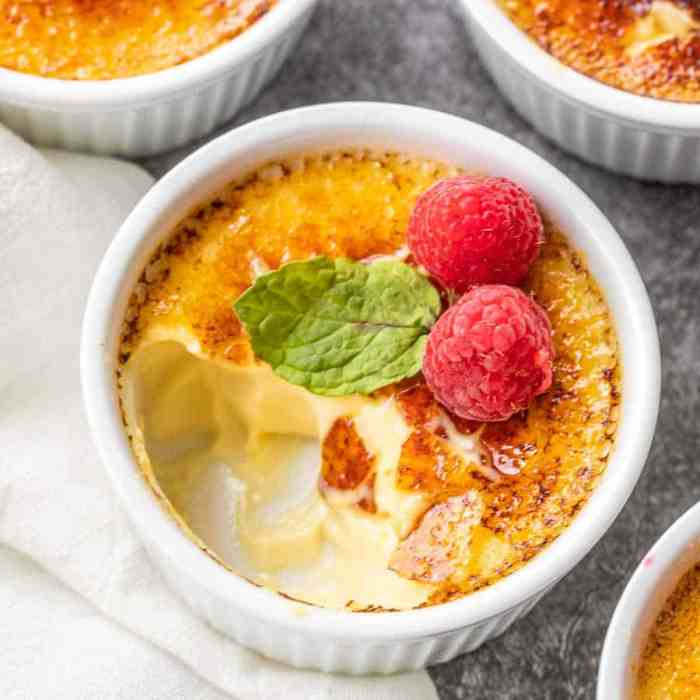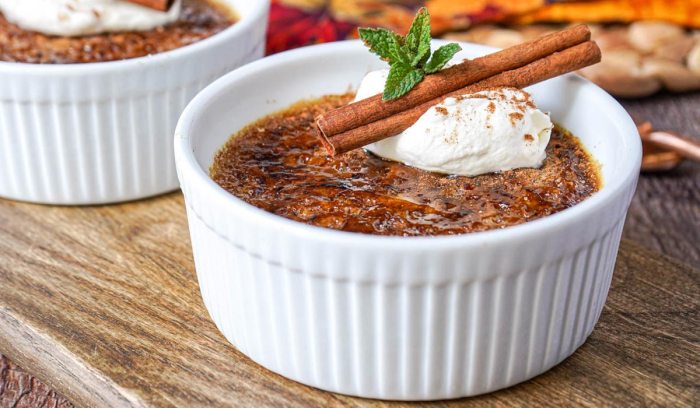
Crab brulee recipe sets the stage for this enthralling narrative, offering readers a glimpse into a story that is rich in detail and brimming with originality from the outset. This exquisite dish, a symphony of flavors and textures, has captivated the hearts and taste buds of seafood enthusiasts worldwide, and now, you too can embark on a culinary journey to recreate this masterpiece in your own kitchen.
Prepare to tantalize your palate as we delve into the intricate steps of preparing crab brulee, from the meticulous selection of ingredients to the art of achieving the perfect caramelized topping. Along the way, we’ll explore the fascinating history and variations of this delectable dish, ensuring that your culinary adventure is both informative and inspiring.
Introduction
Crab Brulee: A Unique Culinary Creation, Crab brulee recipe
Crab brûlée, a delectable fusion of seafood and classic French technique, is a culinary masterpiece that tantalizes taste buds. Its origins can be traced back to the kitchens of innovative chefs who sought to elevate the humble crab to new heights of sophistication.
A Culinary Journey: From Humble Origins to Gastronomic Delight
Crab brûlée emerged as a culinary innovation in the early 20th century, inspired by the classic French dessert, crème brûlée. Chefs experimented with incorporating crab into the custard base, resulting in a savory and umami-rich dish. Over time, crab brûlée gained popularity in restaurants and became a beloved dish among seafood enthusiasts.
If you’re craving a delicious and unique vegetarian dish, look no further than chicken of the woods. This mushroom has a meaty texture and savory flavor that’s sure to satisfy. For a simple yet flavorful preparation, check out this chicken of the woods recipe . It calls for just a few ingredients and can be ready in under 30 minutes.
Ingredients and Preparation

Crab brûlée is a delicious and elegant dish that is perfect for any special occasion. It is made with a combination of crab, custard, and a brûléed sugar topping. The ingredients are simple and easy to find, and the preparation is not difficult.
Ingredients
- 1 pound crab meat, picked over for shells
- 1/2 cup heavy cream
- 1/2 cup milk
- 2 eggs
- 1 egg yolk
- 1/4 cup sugar
- 1/4 teaspoon salt
- 1/4 teaspoon black pepper
- 1/4 cup grated Parmesan cheese
- 1 tablespoon butter, melted
- 1/4 cup sugar for brûléeing
Preparation
Preheat oven to 350 degrees F (175 degrees C). Grease a 9-inch pie plate.
If you’re in search of an easy and flavorful chicken of the woods recipe , look no further! This mouthwatering dish requires minimal ingredients and can be whipped up in a jiffy. Whether you’re cooking for a family gathering or a cozy night in, this recipe will delight your palate with its juicy texture and tantalizing aroma.
In a large bowl, combine the crab meat, heavy cream, milk, eggs, egg yolk, sugar, salt, pepper, and Parmesan cheese. Stir until well combined.
Pour the mixture into the prepared pie plate. Bake for 30-35 minutes, or until the custard is set.
Remove from the oven and let cool for 5 minutes. Sprinkle the remaining 1/4 cup sugar over the top of the custard. Use a kitchen torch to brûlée the sugar until it is golden brown.
Let cool for a few minutes before serving.
Cooking Techniques

Achieving the perfect texture and flavor in crab brûlée requires precise temperature control and careful cooking techniques. Let’s explore the essential steps involved in preparing this culinary delight.
Baking vs. Steaming
The choice between baking or steaming crab brûlée affects the final texture and moisture content of the dish. Baking involves cooking the custard in a preheated oven, resulting in a firmer texture and slightly browned top. Steaming, on the other hand, produces a more delicate and moist texture, as the custard is cooked in a steamy environment.
Looking for a delectable vegetarian dish? Check out this chicken of the woods recipe that will tantalize your taste buds. This mushroom delicacy is a perfect substitute for chicken, offering a meaty texture and savory flavor. Whether you’re a seasoned vegetarian or simply looking to incorporate more plant-based meals into your diet, this recipe is sure to impress.
Caramelizing the Sugar Topping
The signature caramelized sugar topping on crab brûlée adds a touch of sweetness and crunch. To achieve the perfect caramelization, it’s crucial to use a high-quality sugar that will melt evenly and create a rich amber color. Using a culinary torch or placing the dish under a broiler for a few seconds will caramelize the sugar, creating a crisp and flavorful layer.
Presentation and Garnish

The presentation of crab brûlée is crucial for enhancing its visual appeal and creating an unforgettable dining experience. By carefully plating and garnishing the dish, you can elevate its aesthetics and make it a feast for the eyes.
To achieve an elegant presentation, consider plating the crab brûlée in individual ramekins or small bowls. The ramekins should be oven-safe and shallow enough to allow for a crispy top layer. Arrange the ramekins on a serving platter or tray, leaving some space between them for easy serving.
Garnishes and Accompaniments
Garnishes and accompaniments can further enhance the visual appeal and flavor of crab brûlée. Here are a few suggestions:
- Fresh herbs:Sprinkle chopped chives, parsley, or dill over the top of the crab brûlée. These herbs add a vibrant green color and a subtle herbaceous flavor.
- Lemon zest:Finely grate lemon zest over the crab brûlée. The citrusy aroma and flavor complement the seafood perfectly.
- Microgreens:Microgreens, such as pea shoots or arugula, add a delicate texture and a pop of color to the dish.
- Truffle oil:Drizzle a few drops of truffle oil over the crab brûlée. The earthy aroma and flavor of truffles will enhance the richness of the dish.
Variations and Adaptations: Crab Brulee Recipe

Crab brûlée is a versatile dish that can be adapted in numerous ways to suit different tastes and preferences.
For instance, other seafood options like lobster, shrimp, or scallops can be used as a substitute for crab. Experimenting with various herbs and spices can also enhance the flavor profile. Adding a touch of tarragon, chives, or paprika can create unique and flavorful variations.
Sweet and Savory Variations
Crab brûlée can be prepared as both a savory or sweet dish. For a savory version, consider using a richer cheese like Parmesan or Gruyere and omitting the sugar. For a sweeter variation, add a touch of honey or maple syrup to the custard base.
Creative Adaptations
The classic crab brûlée can be creatively adapted into different forms. It can be transformed into individual ramekins for a more elegant presentation or baked in a larger dish for a crowd-pleasing appetizer. Additionally, consider incorporating different toppings like breadcrumbs or crushed crackers for a textural contrast.
Final Wrap-Up

As you savor the final product, a harmonious blend of delicate crab, creamy custard, and crisp caramelized sugar, you’ll realize that the crab brulee recipe is more than just a culinary creation; it’s a testament to the boundless creativity and passion that resides within the realm of cooking.
Whether you’re a seasoned chef or a home cook eager to expand your culinary horizons, this recipe will guide you every step of the way, empowering you to create a dish that will impress and delight your taste buds.
FAQ Section
What is the origin of crab brulee?
Crab brulee is believed to have originated in France, where it is known as “crabe brûlé.” The dish is thought to have been created by chefs in the early 19th century.
What are the key ingredients in crab brulee?
The key ingredients in crab brulee are crab meat, eggs, cream, milk, and sugar. Other ingredients, such as herbs, spices, and cheese, can be added to taste.
How is crab brulee cooked?
Crab brulee is typically cooked in a water bath in the oven. The dish is cooked until the custard is set and the top is golden brown.
What are some variations of crab brulee?
There are many variations of crab brulee, such as using different types of seafood, adding vegetables, or using different types of cheese. Some popular variations include lobster brulee, shrimp brulee, and vegetable brulee.





